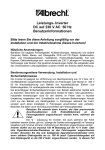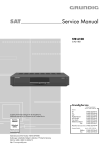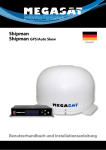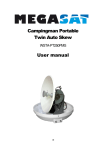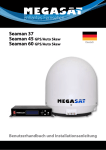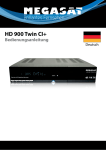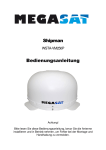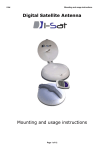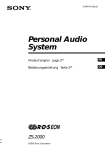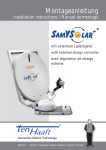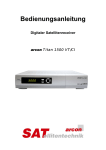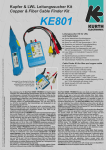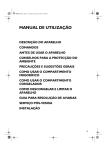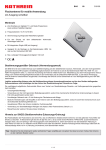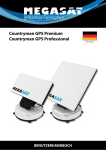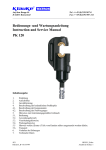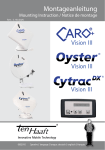Download Campingman TAS_neu
Transcript
Campingman Twin Auto Skew (WSTA-DP250PMS) Bedienungsanleitung Achtung! 1 Bitte lesen Sie diese Bedienungsanleitung, bevor Sie die Antenne installieren und in Betrieb nehmen, um Fehler bei der Montage und Handhabung zu vermeiden. Die Megasat Campingman TAS ist eine voll automatische, selbst ausrichtende Satellitenantenne mit Auto Skew System für bestmöglichen europaweiten Empfang der Satelliten Astra1 , Astra2, Astra3, Astra4, Eutelsat/Hotbird, Thor, Hispasat und Türksat. Diese digitale Antenne ist somit die ideale Empfangslösung für Wohnmobile, LKW, Schiff und PKW. Die Antenne mit dem Positionierer über das Antennenkabel verbinden und einschalten. Der Campingman findet automatisch innerhalb 30-60sec den gewünschten Satelliten. Der kompakte Aufbau in Kuppelform macht diese Antenne absolut unempfindlich gegenüber Wind, Schmutz und Wettereinflüsse. 1. Lieferumfang − − − − − Kuppel-Antenne WSTA-DP250PMS Steuergerät inkl. Stromversorgungskabel Antennenanschlusskabel 10m Antennenanschlusskabel 1m Bedienungsanleitung Klebeset 2. Allgemeines Grundsätzlich empfehlen wir, den Einbau durch Ihren Fachhändler oder eine Fachwerkstatt vornehmen zu lassen! Beachten Sie bitte auch, dass sich bei fester Montage der Antenne die Fahrzeughöhe entsprechend ändert! Wichtig! Bitte halten Sie sich unbedingt an die einzelnen Punkte der Montageanweisung! Beachten Sie bitte auch unsere Gewährleistungshinweise! Vorbereitung: (nur bei fester Montage) 1. Vergewissern Sie sich, dass das Dach Ihres Fahrzeugs ausreichend stabil ist. Bei ungenügender oder zweifelhafter Dachstabilität ist ein ca. 2mm starkes Blech mit ca. 80 x 80 cm auf der Dachaußenhaut zu befestigen. Erkundigen Sie sich dazu bei Ihrem Fahrzeughersteller. 2 Systemkomponenten Antenneneinheit Unter der außen Einheit (Kuppel) befindet sich eine 45cm Hochleistungsantenne. Das Auto Skew System und die neue Elevationstechnik von 15-62° ermöglicht bestmöglichen europaweiten Empfang. Die elegante Kunstoffhaube schütz die Antenne bestens gegen äußere Witterungseinflüsse. IDU (Steuergerät) Mit der IDU wird das Antennensystem gesteuert und mit Strom über das Antennenkabel versorgt. Das Steuergerät wird zwischen Antenne und Receiver geschaltet und wird nur zur Satellitenwahl und Ausrichtung benötigt. Nach erfolgreicher Ausrichtung kann das Gerät ausgeschaltet werden. Achtung: Das Steuergerät darf nur an der Antenne markierten Anschluss betrieben werden. Nur dieser ist zur Ansteuerung vorgesehen. Der 2 Anschluss ist zur Verwendung eines zusätzlichen Receivers oder zur Ansteuerung eines Twin Receivers. 3 Anschluss Montieren Sie die Steuerbox und den Satellitenreceiver im Fahrzeuginneren nicht im Bereich eines Airbags! Achten Sie auf eine sorgfältige Verlegung der Kabel, um Kurzschlüsse zu vermeiden! Achten Sie hierbei auch auf schon vorhandene Kabel! Antenne Satelliten Receiver 2 Antenne Antenne 12VDC~24VDC TV oder Netzteil 230VAC/12VDC 5A Satelliten Receiver 1 Receiver TV 4 1. 2. Schließen Sie den Satellitenreceiver gemäß der entsprechenden Bedienungsanleitung an und verbinden Sie ihn nun mit dem kurzen Koaxial-Zwischenkabel mit der Steuerbox (Reveiver) Verbinden Sie das Stromversorgungskabel mit der Box und der Stromquelle (z.B. Fahrzeugbatterie). Das rote Kabel ist der Pluspol (+), das schwarze der Minuspol (-). ACHTUNG: Schließen Sie das Gerät immer über eine abgesicherte Leitung an (niemals direkt an die Auto Batterie) Bei Verwendung eines Netzteils benötigen Sie eine Leistung von 12VDC/5A. Anschluss für Receiver Anschluss für Antenne Stromversorgung Steuerbox (Rückseite) 3. Achten Sie darauf dass die gewünschte Satellitenrichtung freie Sicht zum Himmel hat. (Orbit Position) oder schlechter oder kein Empfang guter Empfang 4. Schließen Sie das beiliegende lange Koaxialkabel (10m) an der Steuerbox an (Antenna) und verbinden Sie es mit der Antenne. Achten Sie auf den für das Steuergerät vorgesehenen Anschluss. (Bei 2 Receivern oder bei Betrieb eines Twin Receiver verbinden Sie entsprechend das zweite lange Kabel (10m) mit dem 2 Ausgang. 5 Inbetriebnahme und Bedienung 1. Schalten Sie den Monitor/TV-Gerät und den Satellitenreceiver ein. Die grüne LNB Anzeige der Steuerbox leuchtet auf, sobald der Satellitenreceiver eingeschaltet ist. 2. Schalten Sie die Steuerbox ein. Die Anzeige des voreingestellten Satelliten leuchtet rot auf. Die rote Einschaltkontrolle leuchtet auf und die Anzeige des voreingestellten Satelliten beginnt zu blinken, nur in dieser Zeit können Sie einen anderen Satelliten durch drücken der weißen Taste wählen. Bei jedem drücken der Taste springt die Anzeige um eine Satellitenposition weiter. Drücken Sie so lange bis der gewünschte Satellit angezeigt wird, dann leuchtet die Anzeige ständig. Nun startet der Suchvorgang. 3. Wenn ein Satellit gefunden wurde, stoppt die Antenne und führt eine FeinAbstimmung durch. Danach leuchtet die Lock-Anzeige auf und das Bild erscheint auf Ihrem Monitor. Anschließend erlischt die Power-Anzeige und die Antenne geht in den Stromsparmodus. Wenn auf Anhieb nicht der richtige (voreingestellte) Satellit gefunden wurde, geht nach einem kurzen Augenblick die Lock-Anzeige aus, die Anzeige des gefundenen Satelliten leuchtet kurz auf und die Antenne sucht erneut den voreingestellten Satelliten. Der erstmalige Suchvorgang kann bis zu 3 Minuten dauern. Nach einem Standortwechsel ist dieser Vorgang oftmals wesentlich kürzer, da die vorige Position (Elevation) in der Steuerbox abgespeichert wurde. 5. Wenn Sie den Satelliten wechseln wollen, drücken Sie die Sat-Auswahltaste a) in den ersten 3 Sekunden (währen des blinken der Satellitenposition nach dem Einschalten der Steuerbox b) wenn die Antenne bereits auf einem anderen Satelliten steht, so oft auf die Satelliten-Auswahltaste drücken, bis die gewünschte Satellitenanzeige aufleuchtet. Nun wechselt die Antenne auf den neuen Satelliten. ASTRA 2 Sie diese Einstellung für Astra2 auf 28,2° E. ASTRA 3 Wählen Sie diese Einstellung für Astra 3 auf 23,5° E. ASTRA 1 Wählen Sie diese Einstellung für Astra 1 auf 19,2° E HOTBIRD Wählen Sie diese Einstellung für Hotbird auf 13° E ASTRA 4 Wählen Sie diese Einstellung für Astra 4 (Sirius) auf 4,8° E THOR Wählen Sie diese Einstellung für Thor auf 0,8° W HISPASAT Wählen Sie diese Einstellung für Hispasat auf 30° W TURKSAT Wählen Sie diese Einstellung für Türksat auf 42° E 6 Hinweis: Hispasat und Türksat sind auf der gleichen Auswahl Position programmiert. Beim Schalten auf diese Position wird als erstes der Hispasat gewählt und bei wiederholtem Drücken der Türksat. Mobiles Fernsehen Die Antenne wurde dafür entworfen, so effizient und so zuverlässig als möglich zu arbeiten. Wenn die Antenne den ausgewählten Satelliten gefunden hat und die Feinabstimmung beendet ist, geht das Steuergerät in den Standby Betrieb. Jetzt können Sie die IDU ausschalten um unnötigen Stromverbrauch zu vermeiden. Die Versorgung der Satellitenanlage erfolgt durch den Receiver und wird durch die IDU geschliffen. Bedienung IDU Power An/Aus LNB ASTRA2 ASTRA ASTRA4 HISPSAT/TURKSAT ON OFF ASTRA3 POWER LOCK HOTBIRD THOR SATELLITE SELECT POWER Satelliten wählen Drücken bis die gewünschte Satellitenanzeige leuchtet. Funktion LCD Display Power S/W SatellitenSuche. LNB ASTRA 2 ON OFF POWER ASTRA 3 LOCK POWER Power ON. ASTRA Satellit gefunden 7 ASTRA4 HOTBIRD HISPASAT/TURKSAT THOR THOR SATELLITE SELECT Satellit Auswählen Bedienung IDU Einschalten ON OFF POWER . Satellite select Taste drücken bis zum gewünschten Satelliten. SATELLITE SELECT LNB Beim suchen des Satelliten brennt die rote LED. Power LOCK LNB Verfolgung des Zielsatelliten POWER LOCK LNB Satellit gefunden und verriegelt. POWER LOCK 8 Satellitensuche fehlgeschlagen IDU erneut Einschalten. ON OFF POWER Satellit wählen. SATELLITE SELECT LNB Suchen des Satelliten (rote LED). POWER LOCK Wenn der gewünschte Satellit nicht gefunden wird, erfolgt nach ca 2 Minuten ein erneuter Versuch. LNB POWER LOCK 6. Falls es Probleme gibt • • • • • • • Sind Hindernisse (Bäume, Gebäude usw.) in Richtung des Satelliten? Wählen Sie einen anderen Standort. Sind Gebäude in unmittelbarer Nähe kann es zu Reflektionen kommen und die Antenne richtet sich nicht korrekt aus (Standort wechseln) Sind die Antennenkabel korrekt angeschlossen oder defekt (Kabelbruch)? Überprüfen Sie die Antennenstecker und Antennenanschlusskabel. Haben Sie den richtigen Satelliten angewählt? Prüfen Sie, ob der im Receiver eingestellte Satellit mit dem in der Steuerbox angewählten übereinstimmt. Ist die Steuerbox/Sat-Receiver eingeschaltet? Ist die Stromversorgung angeschlossen? Kontrollieren sie die Anschlusskabel. Ist eine ausreichende Versorgungsspannung vorhanden 12V/5A Skew Einstellung kontrollieren. (siehe Tabelle) Die Einstellung erfolgt in der Regel automatisch. 9 Anlage A Europa Position - Raster Bitte entnehmen Sie der Tabelle Ihre Postion (1-25) Die Skew Anpassung (LNB Winkel), finden Sie in der Liste (Skew Anpassung) . 10 Skew Anpassung Um die korrekte Skew Einstellung zu Überprüfen, entfernen Sie die Kuppel der Antenne und vergleichen Sie die LNB Einstellung mit den Tabellenwerten. Raster Position Grid Position TURKSAT 43°°E ASTRA2 28.2°°E ASTRA3 23.5°°E ASTRA1 19.2°°E HOTBIRD 13.0°°E Astra4 4.8°°E THOR 0.8°°W AB3 5.0°°W HISPASAT 30°°W 1 17° 13° 11° 10° 7° 3° 1° -1° -11° 2 14° 10° 8° 6° 4° 0° -3° -4° -14° 3 11° 6° 4° 2° -1° -4° -7° -9° -18° 4 6° 1° -1° -3° -5° -9° -11° -12° -20° 5 2° -2° -4° -6° -9° -12° -14° -15° -22° 6 22° 17° 14° 12° 9° 4° 1° -1° -15° 7 19° 13° 10° 8° 5° 0° -3° -6° -18° 8 15° 8° 5° 2° -1° -6° -9° -11° -22° 9 8° 2° -1° -3° -7° -11° -14° -16° -25° 10 1° -3° -6° -8° -11° -15° -18° -20° -27° 11 29° 21° 18° 16° 12° 6° 2° -2° -19° 12 25° 17° 13° 10° 6° 0° -4° -8° -23° 13 20° 10° 6° 3° -2° -7° -11° -14° -28° 14 10° 2° -1° -4° -9° -15° -18° -21° -32° 15 1° -4° -7° -10° -14° -20° -23° -25° -34° 16 35° 27° 23° 20° 15° 8° 2° -2° -23° 17 30° 21° 17° 14° 8° 0° -6° -10° -29° 18 24° 12° 8° 4° -2° -10° -15° -18° -34° 19 13° 3° -2° -6° -11° -18° -23° -26° -38° 20 1° -5° -9° -13° -18° -25° -28° -31° -41° 21 41° 33° 29° 25° 19° 9° 3° -2° -29° 22 36° 26° 21° 17° 10° 0° -7° -12° -35° 23 29° 16° 10° 5° -2° -12° -18° -23° -41° 24 16° 4° -2° -7° -14° -23° -28° -32° -45° 25 2° -6° -11° -16° -23° -30° -34° -37° -48° 11 LNB Center Line (-) Direction (+) Direction Satelliten Signal + - Auto Skew LNB Signal Die Signale Vertikal (rot) und Horizontal (blau) werden in einem genauen Winkel von 90° gesendet. Die Signale des Satelliten werden im selben Kreuzmuster gesendet. Um einen optimalen Empfang zu erreichen müssen beide Elemente im gleichen Winkel zueinander stehen. Je genauer die Übereinstimmung desto besser der Empfang. Diese Einstellung nennt man Skew Einstellung. Da sich diese Einstellung entsprechend Ihrem Standort ändert (siehe Tabelle), muss der Skew um eine optimale Ausrichtung zu erreichen Angepasst werden. Systeme mit automatischer Skew Einstellung führen das LNB selbständig nach. Bei manuellen Systemen, muss das per Hand vorgenommen werden. Bad Good Best : LNB “Signal collector” : Satellite Signal 12 Ausleuchtzonen Footprint Astra 2N Astra 2S 49dBW 49dBW Astra 1 Hotbird 49dBW 49dBW Fi 13 ASTRA4 Thor 2/3 49dBW 49dBW ASTRA 3 TURKSAT 14 Atlantic Bird 3 Hispasat 49dBW 49dBW Figure B-7 Atlantic bird 3 15 Verarbeitungshinweise 16 17 18 19 20 21 22 Technische Daten Spezifikation Antennen Type Parabola Frequenz Band Ku Band Kuppel Abmessung 700x400mm Antennen Gewicht 12kg Antennen Gewinn 33dBi Minimum EIRP 49dBW Polarisation V/H oder RHCP/LHCP Type of Stabilisation 2-Axis Stepp Motor Elevation Range 15 to 62 (selectable) Azimuth Range Unlimited Tracking Rate 50°/sec Temperatur Bereich Temperature Range -20° to 70° Power 12~24VDC Megasat Industriestrasse 4a D- 97618 Niederlauer Tel. +49 (0) 9776 63567-100 Fax. +49 (0) 9776 63567-144 www.megasat.tv 23 Campingman Twin Auto Skew (WSTA-DP250PMS) User´s Manual 24 T able of contents 1 Introduction Specification………………….…………………………………………………….5 Antenna System Overview…………………………………………………….6 Direct Broadcast Satellite Overview………………………….…………..7 System Components……………………………………………………………8 2 Installation Unpacking the Unit………………………………..…………………….......9 Preparing for the installation……………………………………………….10 Selecting the location………….……………………………………….……...11 Equipment and cable installation…………..…………………………….12 Setting the LNB Skew Angle(Manual Skew version only)………..13 3 Operation Receiving Satellite TV Signals…………….……………………………….14 Turning the System On/Off…………..………………..…………………..15 Changing Channels………………………….…………………...…..………..15 Watching TV…………………………………………………………..……..…..15 Switching between Satellites………………………………………………..15 Operating the IDU……………………………………….…………………..16 4 Troubleshooting Simple Check……………………………………………..………………….19 Causes and Remedies……………………………….……..……………….20 Appendix A Appendix B Appendix C Appendix D How to set the skew angle……………………………..…..…….21 Satellite Coverage Map………………………………..………..…26 Antenna Drawing..….…………………….………………………..28 Adhesive Instruction.…………………….………………………..30 25 Notes, Cautions, and Warnings Caution – Improper handling by unqualified personnel can cause serious damage to this equipment. Unqualified personnel who tamper with this equipment may be held liable for any resultant damage to the equipment. Install under DRY condition ONLY! Do not install this system in the rain, or under any wet conditions. Moisture may affect electronics and void warranty! Warning – Need 2 people to install the antenna onto the roof. Do not try to install the antenna by yourself. Note – Before you begin, carefully read each of the procedures in this manual. If you have not performed similar operations on comparable equipment, do not attempt to perform these procedures. Specification Antenna Type Parabola Frequency Band Ku Band Radome Dimension 700x400mm Antenna Weight 12kg Antenna Gain 33dBi Minimum EIRP 49dBW Polarization V/H or RHCP/LHCP Type of Stabilization 2-Axis Step Motor Elevation Range 15° to 62° Azimuth Range Unlimited Tracking Rate 50°/sec Temperate Range -20° to 70° Power 12~24VDC LNB Twin Auto Skew Table 1-1 Specification 26 I ntroduction WSTA-DP250PMS satellite antenna system is the innovative and a technologically advanced satellite Stationary system. WSTA-DP250PMS has a unique combination of stateof-the art components with the most sophisticated satellite acquisition and tracking programs to provide the following features: ■ ■ ■ ■ ■ ■ ■ Fast satellite acquisition Compatible with any Satellite Receiver Compatible with all Direct Broadcast Satellites (DBS) Built-in Digital Broadcast Receiver(DVB) Capable of High Definition receiving Automsatic Skew Twin output for 2 Receivers 27 Antenna System Overview A complete satellite TV system, illustrated in Figure 1-1, includes WSTA-DP250PMS antenna connected to a IDU, a satellite TV receiver, and a television set. Campingman DP250PMS Antenna Unit Satellite Receiver 2 Antenna Antenna Vehicle Power 12V/24VDC TV or Power supply 230VAC/12VDC 5A IDU(In Door Unit) TV Satellite Receiver 1 Figure 1-1 System Diagram 28 Direct Broadcast Broadcast Satellite Overview Direct Broadcast Service (DBS) satellites broadcast audio, video and data information from satellites located 22,000 miles in space. A receiving station, such as WSTA-DP250PMS antenna, should include a dish and satellite receiver to receive the signals and process them for use by the consumer audio and video equipment. The system requires a clear view of the satellite to maximize the signal reception. Blocked ! Free ! bad or no signal ! good signal ! Figure 1-2 Satellite Blockage Objects such as tall lighthouse, bridges and big ship that block this view will cause a loss of signal. The signal will be quickly restored once the antenna has a clear line of sight again. Heavy rain, cloud, snow or ice may also interfere with the signal reception quality. If the satellite signal is lost due to blockage or severe weather condition, services from the receiver will be lost (picture will freeze frame and may disappear). When the satellite signal strength is again high enough, then the receiver will resume providing desired programming services. 29 System Components Antenna Unit The antenna unit houses the antenna positioning mechanism, LNB (low noise block), and control elements within a radome. Weathertight connectors join the power, signal, and control cabling from the belowdecks units. IDU(InDoor Unit) The IDU is the system’s user interface, providing access to the system and its functions through an LCD and three buttons. The IDU also serves as the vehicle’s junction box, allowing the system to use vehicle power, and supply and receive data to/from the antenna unit. Figure 1-3 System Components 30 I nstallation This section offers a general explanation of how properly to install WSTA-DP250PMS antenna. Installation of WSTA-DP250PMS antenna must be accomplished by or under the supervision of an authorized dealer for the Limited Warranty to be valid and in force. The steps in the installation and setup process are as follows: Unpacking the unit 1. Open box and remove packing material. The following items are included in the packaging of Free Way 1S antenna. Item Description Quantity 1 Megasat WSTA-DP250PMS Antenna Unit 1 each 2 Megasat IDU(In Door Unit) 1 each 3 Power Cable(1.5m) 1 each 4 Coaxial Cable (10m) 1 each 5 Coaxial Cable (1m) 1 each 6 User Manual 1 set 7 Gluing set (Primer 50ml, Applicator, Special adhesive 310ml) 1 set Table 2-1 Parts included 2. Lift dome out of box vertically. Then lift unit out of box vertically. Do not turn box and “roll” out, or turn upside down to remove. Lift Unit straight up out of the carton! Figure 2-1 Unpacking the unit 31 Preparing for the installation installation Install Tools and Materials WSTA-DP250PMS antenna system is designed for simple installation and setup. However, the following list of equipment or items should be available during installation of WSTADP250PMS antenna. ■ ■ ■ ■ Electric drill and drill bits Socket wrench Silicon sealant Fastener suitable for specific application 1. Verification of the Vehicle’s Power Supply. ■ Confirm that the vehicle’s power supply is 12VDC~24VDC or Power supply with 230VAC to 12VDC 5A. 2. Verification of the Satellite Receiver and IDU’s attachment and the electricity supply ■ Attach Satellite Receiver and IDU in the interior of the vehicle or the trunk. ■ Connect the power of Satellite Receiver and IDU. ■ Once the power of Satellite Receiver and IDU is verified, it confirms that both Satellite Receiver and IDU are working normally. 3. Procedure of the satellite’s attachment and installation. ■ Attach the satellite on the flat surface area of the vehicle’s roof. ■ Connect each end of the Coaxial antenna cable to the satellite’s terminal and the IDU. ■ Connect the IDU and the Satellite Receiver box together through the coaxial cable. ■ Make sure that the satellite is working normally, once the power is supplied. Warning : Things to consider when installing the antenna. ■ Turn off the power when attaching or detaching the antenna. ■ Make sure that the attached satellite is fixed on the flat surface. ■ When attaching, ensure that all the products are adhered properly. ■ Ensure that all the cables are connected properly. 32 Selecting Selecting the location Determine the optimum mounting location for the antenna radome assembly. It should be installed where : 1. The antenna has a clear line-of-sight view to as much of the sky as is practical. Choose a location where masts or other structures do not block the satellite signal from the dish as the vehicle turns. 2. The antenna is at least 5 feet away from other transmitting antennas (HF, VHF and radar) that may generate signals that may interfere with WSTA-DP250PMS antenna. The further away WSTA-DP250PMS antenna is from these other antennas, the less impact their operation will have on it. 3. Direct radiation into the antenna from vehicles radar, especially high power surveillance radar arrays, is minimized. The radome should be as far away from the vehicles Radar as possible and should NOT be mounted on the same plane as the vehicles Radar. 4. The antenna radome assembly should be rigidly mounted to the vehicle. If necessary, reinforce the mounting area to assure that it does not flex due to the vehicle motion or vibration. If these conditions cannot be entirely satisfied, the site selection will inevitably be a “best” compromise between the various considerations. Perform a through site inspection on the roof for the antenna to be mounted. 1. The antenna must have a clear view of the sky and the horizon at all the directions to avoid blockage of the satellite signal. 2. The antenna should be on the top of the vehicle. Best Location Poor Location Figure 2-2 Selecting the location 33 Equipment and cable installation installation This offers a general explanation of how to install the IDU and satellite receiver properly to the inside of vehicle connecting with coaxial cable. 1. The Coaxial cable is routed from the antenna to the IDU inside the vehicle. 2. After Once deciding where to place the IDU and satellite receiver, make sure that both units are placed in a dry and protected area. 3. The IDU and satellite receiver should be placed away from any heat source and in an area with proper ventilation. 4. Ensure that there are at least 3cm of space around both units for ventilation and connection of cables. Do not stack the units on top of each other. 5. The following describes the basic wiring configurations for DP250PMS antenna. ■ Connect the Coaxial cable to WSTA-DP250PMS antenna port on the back of IDU ■ Connect one end of the supplied coaxial cable to the receiver port on the back of the IDU ■ Connect the other end of the coaxial cable to the satellite receiver ■ The second receiver you can directly connect the coaxial cable from antenna to the satellite receiver. Setting the LNB skew angle Figure 2-3 Satellite signals 34 Signals transmitted in vertical(red) and horizontal(blue) wave offset exactly 90º from each other. Since linear satellite signals are oriented in a precise cross pattern, Free Way 1S antenna’s receiving element, called an LNB (low-noise block) must be oriented in the same way to optimize reception. This orientation adjustment is referred to as the LNB’s “skew angle.” Figure 1-4 illustrates how skew determines the amount of signal the LNB collects. The more signal, the better reception. Bad skew Good skew Best skew : LNB “signal collector” : Satellite Signal Figure 2-4 Best Skew Angle LNB Center Line (-) Direction (+) Direction Attention – The Model Megasat Campingman TAS (Twin Auto Skew) work full automatically Do not work on the auto skew system (only for engineer). The correct skew setting varies depend on your geographic location, since the orient-tation of your antenna to the satellite changes as you move. For complete details about adjusting the LNB’s skew angle, see “Appendix A – How to Set the Skew Angle” 35 O peration WSTA-DP250PMS antenna system is easy to use. Under normal conditions, operation of WSTA-DP250PMS antenna requires no intervention from the user. Antenna unit initialization , satellite acquisition and skew is completely automatic. Receiving Satellite TV Signals Television satellites are located in fixed positions above the Earth’s equator and beam TV signals down to certain regions of the planet. To receive TV signals from a satellite, you must be located within that satellite’s unique coverage area. To check it, see “Appendix B – Satellite Coverage Map” In addition, since TV satellites are located above the equator, WSTA-DP250PMS antenna must have a clear view of the sky to receive satellite TV signals. Anything that stands between the antenna and the satellite can block the signal, resulting in lost reception. Common causes of blockage include lighthouses, boat masts, trees, buildings, and bridges. Heavy rain, ice, or snow might also temporarily interrupt satellite signals. Turning the System On/Off Since power to WSTA-DP250PMS system is controlled by the IDU, you can turn the antenna on or off by applying/removing operating power to the IDU. Turning on the System Follow the steps below to turn on your WSTA-DP250PMS System. 1. Make sure the antenna has a clear view of the sky. 2. Turn on your satellite TV receiver and TV. 3. Apply operating power to the IDU. 4. Wait one minute for system startup. The IDU will display the Tracking Satellite screen after system testing is complete. Turning off the System Follow the steps below to turn off your WSTA-DP250PMS System. 1. Remove operating power from the IDU. 2. Turn off your satellite TV receiver and TV. Changing Channels If you have followed the installation instructions, your system should be set to the satellite of your choice and the system should have downloaded the appropriate channel guides. When WSTA-DP250PMS antenna system and satellite receiver is properly configured, it is easy to change the channel using the remote control that normally comes with the receiver unit. 36 Watching TV WSTA-DP250PMS antenna is designed to operate as efficiently and as reliably as possible when the vehicle is moved and anchored. It is also the quickest satellite acquisition system available among WSTA-DP250PMS antennas. If you have anchored the vehicle and the antenna has completed to searching selected satellite, turn off IDU Power to avoid unnecessary use of power. Because the LNB receives its power from the Satellite Receiver through the IDU, the antenna will continue to receive the satellite TV signals. Switching between Satellites You can switch between satellites using the IDU by pressing Satellite select buttons. Follow the steps below to switch to another satellite. 1. Ensure that the LEDs turn on. If antenna is disconnected, all led will blink. TRACKING SEARCH SLEEP Figure 3-1 IDU LED 2. Press the Satellite select buttons to switch to another satellite. 3. The antenna shifts to track selected satellite. Wait for the Tracking Satellite screen. Operating the IDU Appearance Power S/W TRACKING ASTRA2S ON OFF ASTRA2N SEARCH HOTBIRD ASTRA1 SIRIUS SLEEP AB3 HISPSAT SATELLITE SELECT POWER Satellite select button Figure 3-2 Appearance of IDU 37 Functions of LCD Display Power S/W You can change the satellite by pushing this It is tracking a satellite. TRACKING ASTRA2S ON OFF ASTRA2N SEARCH HOTBIRD ASTRA1 SIRIUS AB3 HISPSAT SLEEP SATELLITE SELECT POWER It is searching a satellite. It is in sleep mode. Satellite select button Figure 3-3 Functions of LED General Operation Order Turn the power switch on. ON OFF POWER . Push the Satellite select buttons to choose satellite. SATELLITE SELECT Red LED turns on for searching the satellite. TRACKING SEARCH SLEEP 38 TRACKING SEARCH SLEEP TRACKING SEARCH It is tracking the target satellite. SLEEP If detacted satellite is choosen satellite, it goes to auto_sleep mode. In case of search failure ON OFF Turn the power switch on. POWER Push the Satellite select buttons to choose satellite. SATELLITE SELECT Red LED turns on for searching the satellite. TRACKING TRACKING SEARCH SLEEP SEARCH SLEEP If the antenna cannot find selected satellite, it goes to sleep mode during about 2 minutes with turning on 2-LED. And then the antenna will search the satellite again. 39 T roubleshooting There are a number of common issues that can affect the signal quality or the operation of WSTA-DP250PMS antenna system. The following sections address these issues and potential solutions. Simpl e check…………… ……. ….… ……………… ………… ………… …. 2 4 Causes and Remedies…..………………..………………………………….25 Simple check Can the antenna see the satellite? The antenna requires an unobstructed view of the sky to receive satellite TV signals. Common causes of blockage include trees, buildings, bridges, and mountains. Is there excessive dirt or moisture on the antenna dome? Dirt buildup or moisture on the dome can reduce satellite reception. Clean the exterior of the dome periodically. Is it raining heavily? Heavy rain or snow can weaken satellite TV signals. Reception should improve once the inclement weather subsides. Is everything turned on and connected properly? Make sure your TV and receiver are both turned on and set up for the satellite input. Finally, check any connecting cables to ensure none have come loose. Causes and Remedies Receiver Fault Your satellite TV receiver might be set up incorrectly or defective. First check the receiver’s configuration to ensure it is set up for the desired programming. In the case of a faulty receiver, refer to your selected receiver’s user manual for service and warranty information. Satellite Coverage Issue Television satellites are located in fixed positions above the Earth’s equator and beam TV signals down to certain regions of the planet (not worldwide). To receive TV signals from a satellite, you must be located within that satellite’s unique coverage area. See “Appendix-B Satellite Coverage Map” 40 Satellite Signal Blocked The WSTA-DP250PMS Antenna needs a clear line of sight (LOS), view to the satellite for uninterrupted reception. Objects such as tall lighthouse, bridges and big ship that block this view will cause a loss of signal. The signal will be quickly restored once the antenna has a clear line of sight again. Heavy rain, cloud, snow or ice may also interfere with the signal reception quality. If the satellite signal is lost due to blockage or severe weather condition, services from the receiver will be lost (picture will freeze frame and may disappear). When the satellite signal strength is again high enough, then the receiver will resume providing desired programming services. Satellite Frequency Data Changed If some channels work, while one or more other channels do not, or if the antenna cannot find the selected satellite, the satellite’s frequency data might have changed. Improper Wiring If the system has been improperly wired, the antenna will not operate correctly. Refer to the User Manual for complete system wiring information. Loose Cable Connectors We recommends periodically checking the antenna unit’s cable connections. A loose cable connector can reduce signal quality or prevent automatic satellite switching using the receiver’s remote control. Fasten the cable connector. Appendix A How to Set up the Skew Angle Signals transmitted in vertical and horizontal wave offset exactly 90º from each other. Since linear satellite signals are oriented in a precise cross pattern, Free Way 1S antenna’s receiving element, called an LNB (low-noise block) must be oriented in the same way to optimize reception. This orientation adjustment is referred to as the LNB’s “skew angle.” The correct skew setting varies depending on your geographic location, since the orientation of your antenna to the satellite changes as you move. This appendix provides how to set up the skew angle. 41 European Position Grid If you wish to determine the Skew Angle(LNB), use the position grid(Figure A-1 European Position Grid) and table(TableA-1 Regional Skew angle) on page 32. Figure A-1 Europe Position Grid If you wish to set the correct skew, see “TableA-1 Regional Skew angle”. The correct skew setting varies depending on your geographic location, since the orientation of your antenna to the satellite changes as you move. 42 Grid Num. 1 ASTRA2N 28.2°°E ASTRA2S 28.2°°E ASTRA1 19.2°°E HOTBIRD 13.0°°E SIRIUS 4.8°°E THOR 0.8°°W AB3 5.0°°W HISPASAT 30°°W 13° 13° 10° 7° 3° 1° -1° -11° 2 10° 10° 6° 4° 0° -3° -4° -14° 3 6° 6° 2° -1° -4° -7° -9° -18° 4 1° 1° -3° -5° -9° -11° -12° -20° 5 -2° -2° -6° -9° -12° -14° -15° -22° 6 17° 17° 12° 9° 4° 1° -1° -15° 7 13° 13° 8° 5° 0° -3° -6° -18° 8 8° 8° 2° -1° -6° -9° -11° -22° 9 2° 2° -3° -7° -11° -14° -16° -25° 10 -3° -3° -8° -11° -15° -18° -20° -27° 11 21° 21° 16° 12° 6° 2° -2° -19° 12 17° 17° 10° 6° 0° -4° -8° -23° 13 10° 10° 3° -2° -7° -11° -14° -28° 14 2° 2° -4° -9° -15° -18° -21° -32° 15 -4° -4° -10° -14° -20° -23° -25° -34° 16 27° 27° 20° 15° 8° 2° -2° -23° 17 21° 21° 14° 8° 0° -6° -10° -29° 18 12° 12° 4° -2° -10° -15° -18° -34° 19 3° 3° -6° -11° -18° -23° -26° -38° 20 -5° -5° -13° -18° -25° -28° -31° -41° 21 33° 33° 25° 19° 9° 3° -2° -29° 22 26° 26° 17° 10° 0° -7° -12° -35° 23 16° 16° 5° -2° -12° -18° -23° -41° 24 4° 4° -7° -14° -23° -28° -32° -45° 25 -6° -6° -16° -23° -30° -34° -37° -48° Table A-1 Regional Skew Angle 43 Appendix C Antenna Drawing 44 Antenna Drawing Figure 1-1 Free way 1S Drawing Megasat Industriestrasse 4a D- 97618 Niederlauer Tel. +49 (0) 9776 63567-100 Fax. +49 (0) 9776 63567-144 www.megasat.tv 45













































